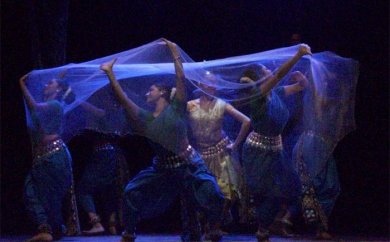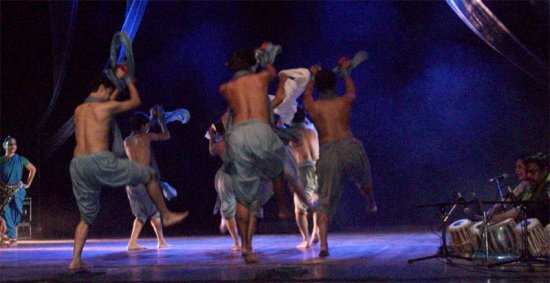 |
|
 |
|
 Monsoon memories at the Malhar Festival Monsoon memories at the Malhar FestivalText & pics: Nita Vidyarthi e-mail: nitavidyarthi@gmail.com September 27, 2014 As a part of the Malhar Festival organised by ITC Sangeet Research Academy (SRA) at the G.D. Birla Sabhagar, Kolkata, Sharmila Biswas and her repertory dancers of the Odissi Vision Movement Centre in music collaboration with SRA presented “Monsoon Memories” on the first evening after the vocal recital in Raga Mian-Malhar, Vaishnaba Janato and Vande Mataram by the very talented Kumar Mardur. Sharmila’s vibrant production conceived by her, expressed the myriad moods of the Indian monsoon through a choreographic composition and narrative of her own based on classical Odissi and a touch of her favourite, the West Odisha folk dance forms with music inputs by the musicians of SRA. The presentation with a contemporary touch was an expression of nature touching each of the five senses through the love story of the young girl Prithvi and her beloved Megh who storms into her life to throw her into total disarray. Prithvi blossoms into a charming maiden who gathers herself and gains composure to reinvent herself through the confidence and promise of a glorious autumn. The curtain rises to an interesting stage set up. The dimly lit dark stage gradually gained in intensity with the instrumentalists sitting on the right and the vocalist on the left, all on an elevated platform, dressed in black with green ‘uttariyas.’ Dancers lay prostrate in a circle on the performance space in-between with the narrator Kathakali Jana of SRA, at the centre. This forms a sort of backdrop for the dramatic presentation. With the strains of the Santhali song “Bando dhani geyil dhani” by Mary Handsa, the dancers rise and the performance begins as Prithvi narrates her story, her memories, her joys and vacuum in life till she reaches the happiness in autumn. The solemnity of Dhrupad, the poignancy of “Aashad” through strokes of violin, when suddenly storm lashes in, the joyous Kheyals like “Badariya ayi re sawan ki’ make for fascinating, soul-stirring music. But here, one missed the “Badariya,” the showers, the joy of rains especially in Sawan. The deep-rooted romanticism is expressed more through songs than through dance.  Shubhajit Das as Megh storming in entrapping Prithvi in the storm with a large organza drape as an artistic aid looks effective. Short lines in Maithili like “Awala Nawala Kishore” added variety to the narrative. Sharmila as the mature Prithvi showed her skills in abhinaya and the group their training with fine dancing. Especially enjoyable was the item with manjira by male dancers as the female ones looked on and finally joined them. The ladder in the middle as a prop had minimum significance. Costume by Niloy Sengupta was pleasing but lights by Dinesh Poddar were overdone with a stark blue and the shadows cast hindered the visibility of the dancers. The rig at the back of the stage could be rearranged as the rear was soaked in darkness many a time preventing the choreography to shine. But the use of net under which Saswati Garai in a golden costume as autumn gradually emerges is the most beautiful visual imagery in the whole production. Even though the music (both vocal and instrumental) by Om Dadarkar and the ITC SRA team remained the high point of the production, the execution of the oldest Pallavi of Pankaj Charan Das was a real treat, well executed by the dancers. Dr. Nita Vidyarthi is a critic of performing arts, specialising in dance, dance theatre and expressions and is a regular contributor to The Hindu, and the Statesman Kolkata in dance, vocal music and theatre. She is trained in Kathak, Bharatanatyam and Manipuri as well as vocal, semi-classical music and Rabindra Sangeet. A Science communicator, Ph.D. in Polymer Science, Commonwealth Scholar and a retired Professor of Chemistry, Nita devotes most of her time to dance and theatre writing. |